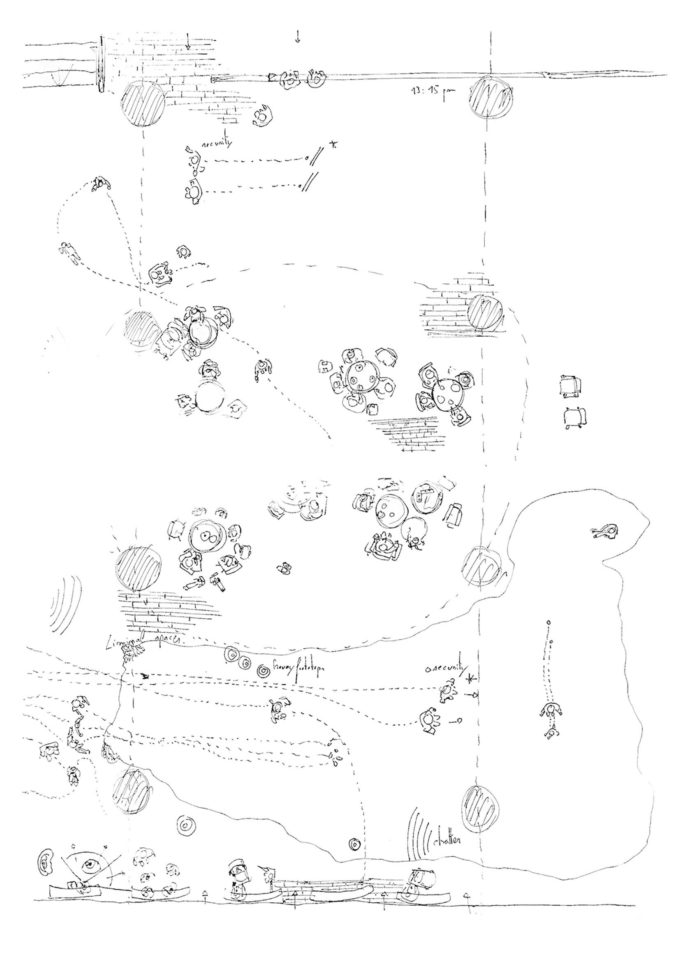Museums are the “cathedrals of our time”: 1 they have become places of predilection to any city, where culture is displayed as a means to enrich the experience of places.
The metaphor of museum as market was suggested as part of a conversation on the change of location of the Museum of London to the disused buildings of Smithfield Market. The underlying provocation asked if the museum could be conceptualised as a market and to push it further, if the museum could be urbanised. Various themes were addressed during the conversation; the particular aspects that I wish to develop relate to accessibility – drawing upon comments of making a museum an inclusive space for all. I wish to discuss the potential of such a radical idea as well as the limits of its implementation.
To me, the appreciation of urbanity lies in the exposure to multiple realities ceaselessly unfolding. This exposure is indeed enriching at an individual as well as collective level. Without this exposure, how could one position themselves in the intricate web of social constructs? Though equally, with all that I am exposed to, there is all that falls out of my range whether from self-ignorance or from the socio-political barriers that condition my limitations.
I suppose being urban then is to recognise and engage with the parts of the whole, whilst understanding how we navigate through it. In other words to be cosmopolitan: one who accommodates to the values and practices of cultures different to their own.
The conversation on urbanising the museum asked what it would mean for the museum to be urban. As in, can the conditions for urbanity – the concentration of extremes and differences, the access to a multiplicity of views and simultaneity of diverse thinking – be designed within an institutional space? (I use the definition of urbanity as mentioned by novelist Sarah Schulman in her novel: the gentrification of the mind: witness to a lost imagination)
This question seems relevant to the Museum of London which is indeed the museum of the city and the urban. Part of my interest lies in what it would mean to make the museum accessible and to be truly representative of the diversity of people who live in London.
Following the conversation, I’d like to develop on 3 points which I find of interest.
1: Transparent contracts
The hidden exchange that occurs in a museum set under the sign of “free entry” and the act of benevolence which can be seen as positive are also problematic. During the Victorian era, museums were used as political instruments to educate as well as to moralise the lower classes. This hidden transaction which is at times unclear to whom it benefits is a limitation in the accessibility of a museum.
In the 60’s, the French sociologist Pierre Bourdieu criticised museums for their role in maintaining status quo; by strengthening on the one hand a feeling of belonging to those who are privileged and able to see art and on the other hand a feeling of exclusion to those who are not taught to see art.
Could the museum operate with transparent contracts clarifying the nature of the exchange for all parties, setting the conditions upon which value is created and distributed equally? This could either be imagined as a ritual before one enters the museum, following Marina Abramović’s contracts with visitors to stay on the premise for a certain amount of time – or alternatively one could imagine the collection be diffused throughout the city boroughs and become less institutionalised.
2: From transparent contracts to free spaces
Free spaces as in public space is becoming increasingly scarce in London, (polemic of disguised public space as Pops) 2] . The prospects of creating/giving up space for free expression is appealing with all the risks it entails. What elements should this space include? Which aesthetic should it convey? What infrastructure can it offer?
The space might take time to be invested – although it could be supported by the programmatic and curating of other adjacent spaces. The analysis of particular case studies such as the Madrid Matadero or the 104 in Paris, both cultural centres, would offer interesting models to understand how this is enacted.
3: A public calendar: parameters for shifting ownership towards stewardship
Calendars are effective tools for the allocation of space at a given time. I am particularly interested in the way they enable the structuring of space with activities occurring unexpectedly side by side. Dance rehearsal spaces in public spaces use calendars. The London Southbank centre is one of those examples: where it offers a space on the lower ground floor which is allocated for free rehearsals.
Whilst visiting, I mostly encountered hip hop crews practising, a few teenagers and many kids activating the space with various motions. The overlapping of such activities creates a vibrant atmosphere where one could easily improvise with the dancers or simply sit and watch. Could the use of a public calendar offer an interesting tension between, on the one hand, curated and programmed spaces and on the other hand various ephemeral activities such as: dancing, reading groups, chess duals or poetry readings?
Luc Sanciaume is an MArch student at CSM who worked on a placement with Theatrum Mundi through April and May 2018. This article was written as a response to the workshop Making Cultural Infrastructure: urbanising the museum, that took place at the Museum of London.
- https://www.telegraph.co.uk/culture/art/art-features/7623851/Tate-Modern-a-symbol-of-Britain-as-it-would-like-to-be.html
- https://www.theguardian.com//cities/2017/jul/24/revealed-pseudo-public-space-pops-london-investigation-map
